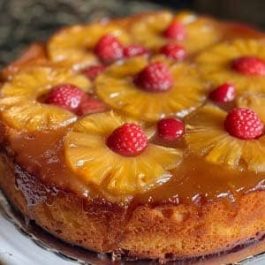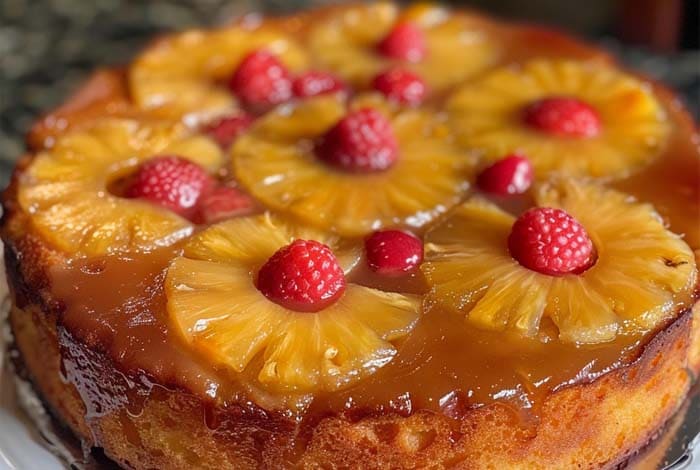Introduction to Pineapple Upside Down Cake
Pineapple Upside Down Cake, a delicious dessert featuring caramelized pineapple slices and cherries atop a moist, fluffy cake, has roots dating back to the early 20th century. Its creation is often attributed to the advent of canned pineapple by companies like Dole, which made pineapple more accessible to the American public. The cake gained widespread popularity when it was featured in a 1925 American contest for recipes using canned pineapple, showcasing its versatility and appeal. Since then, this dessert has become a beloved classic, celebrated for its delightful combination of sweet and tangy flavors and its visually appealing presentation.
The cake’s significance lies not only in its taste but also in its cultural impact, symbolizing a period of innovation in American baking and homemaking. It embodies a time when canned goods became staples in pantries, leading to new culinary creations. The Pineapple Upside Down Cake, with its simple yet satisfying flavors, continues to be a favorite at gatherings, embodying warmth, comfort, and nostalgia.
Essential Ingredients and Variations
The traditional Pineapple Upside Down Cake calls for a straightforward list of ingredients that combine to create its unmistakable taste and texture. The base ingredients include butter, brown sugar, pineapple slices, maraschino cherries, a cake mix or flour, sugar, eggs, and pineapple juice. These components work together to form the cake’s caramelized topping and tender crumb.
- Butter and brown sugar are melted together to create the caramelized layer that characterizes the cake’s topping.
- Pineapple slices and maraschino cherries are arranged on this sugary base, adding a fruity sweetness and vibrant color.
- The cake batter, made from cake mix or flour, sugar, eggs, and pineapple juice, is poured over the fruit, baking into a moist and flavorful base that perfectly complements the caramelized topping.
For those with dietary restrictions, there are numerous variations and substitutes that can be incorporated. For example, gluten-free flour blends can replace all-purpose flour for those avoiding gluten, while plant-based butter and egg substitutes offer a way to veganize the cake. Furthermore, to reduce sugar intake, alternative sweeteners suited for baking can be used both in the cake batter and the caramelized topping. These adjustments allow everyone to enjoy this classic dessert without compromising on taste or texture.
By embracing both traditional techniques and modern adaptations, Pineapple Upside Down Cake remains a timeless dessert that continues to bring joy and sweetness to tables around the world.
Preparation and Baking Tips
Creating the perfect Pineapple Upside Down Cake involves a blend of art and science, with each step playing a crucial role in achieving that ideal balance of moist cake and caramelized topping. Here’s a step-by-step overview and some key tips to ensure success:
- Preheat your oven to the right temperature as specified in your recipe. Consistent oven temperature is crucial for even baking.
- Prepare the topping first by melting butter and evenly spreading brown sugar over it in your baking pan. This mixture will caramelize as it bakes, creating the signature topping for the cake.
- Arrange the pineapple and cherries on top of the brown sugar mixture carefully. For a visually appealing design, place a pineapple ring in the center and arrange the cherries and remaining pineapple slices around it. Pat the fruit dry before arranging to prevent excess moisture.
- Mix your batter ensuring not to over-mix to keep the cake light and fluffy. Properly creaming the butter and sugar is key, as is adding eggs one at a time for structure.
- Pour the batter over the arranged fruit carefully and bake as directed until the cake is golden brown and a toothpick comes out clean.
How to Flip the Cake Perfectly
Flipping the Pineapple Upside Down Cake is perhaps the most nerve-wracking part of the baking process, but with the right technique, it can be smooth and successful:
- Allow the cake to cool slightly before flipping, but don’t wait too long. A 10-minute cooling period is often recommended to let the cake set without letting the caramelized sugar harden.
- Choose the right plate or platter that is larger than the cake pan and has a slight edge to catch any drips.
- Loosen the edges of the cake with a knife or offset spatula, place the serving plate on top of the cake pan, then quickly and carefully flip both over. Let gravity do the work to release the cake onto the plate.
Serving Suggestions
Serving Pineapple Upside Down Cake in the right way can enhance its flavors and presentation:
- Homemade whipped cream is a delightful accompaniment to this cake. Lightly sweetened whipped cream can balance the sweetness of the caramelized fruit topping.
- Presentation is key; serve each slice with a dollop of whipped cream on the side or a drizzle of extra pineapple juice for added moistness.
- Garnish with additional cherries or a sprinkle of toasted coconut flakes for a beautiful and appetizing finish.
Remember, the key to a perfect Pineapple Upside Down Cake lies in the preparation and attention to detail at every step of the process.
Storage and Freezing
Storing and freezing Pineapple Upside Down Cake properly can help extend its freshness and ensure it retains its texture and flavor:
- For Storage: Pineapple Upside Down Cake can be covered and stored in the refrigerator for 2 to 3 days. Keeping it in the fridge helps maintain its moistness and prevents the topping from becoming too hard.When ready to enjoy again, you might want to let it come to room temperature or warm it up slightly to revive its original texture and flavor.
- For Freezing: Although freezing is not highly recommended due to potential texture changes, it is possible. If you choose to freeze the cake, wrap it tightly in several layers of plastic wrap and then aluminum foil to prevent freezer burn. It can be stored in the freezer for up to three months. Thaw in the refrigerator overnight before serving.
FAQs
- Can I use fresh pineapple instead of canned? Yes, fresh pineapple can be used instead of canned. It might require a bit more preparation, such as peeling and coring, but it can offer a fresher taste. Remember to slice it thinly for even cooking and caramelization.
- What can I substitute for maraschino cherries? If maraschino cherries aren’t your favorite or you’re looking for a natural alternative, consider using fresh cherries, cranberries, or even raspberries for a burst of color and tartness that complements the sweetness of the pineapple.
- How do I prevent the cake from sticking to the pan? Ensuring your cake doesn’t stick starts with properly greasing the pan. Use butter or a non-stick baking spray, and consider lining the bottom with parchment paper for added security. After baking, let the cake cool for a few minutes before flipping it; this allows the caramel to slightly solidify and reduces sticking.
- Can I make Pineapple Upside Down Cake gluten-free? Yes, you can make this cake gluten-free by substituting the all-purpose flour with a gluten-free flour blend. Look for one that can be used as a 1:1 replacement to ensure the texture of the cake remains light and fluffy.
- Is it possible to veganize Pineapple Upside Down Cake? To veganize the cake, use plant-based substitutes for butter, eggs, and milk. There are many vegan butters available, while flaxseed or chia seeds mixed with water can replace eggs, and any non-dairy milk can substitute for cow’s milk. These swaps can help you enjoy a vegan version without compromising on taste or texture.
Variations of Pineapple Upside Down Cake
Exploring different approaches to Pineapple Upside Down Cake allows for a creative and personal touch to this classic dessert. King Arthur Baking, Averie Cooks, and Gemma’s Bigger Bolder Baking offer innovative ideas that push the boundaries of the traditional recipe.
One exciting variation includes incorporating different fruits such as peaches or cranberries for a seasonal twist. Another innovative idea is the incorporation of spices like cinnamon or nutmeg into the batter, adding warmth and depth to the cake’s flavor. Some bakers have experimented with the cake’s structure itself, creating individual servings or even integrating chocolate elements into the batter for a rich, decadent twist.
Healthier Alternatives
To make Pineapple Upside Down Cake healthier, consider substitutes that reduce its sugar and fat content without compromising flavor. Using whole wheat flour or almond flour in place of all-purpose flour can add fiber and nutrients. For sugar, options like coconut sugar or pure maple syrup can offer a more natural sweetness. Applesauce or mashed bananas can replace some of the butter to lower the fat content while keeping the cake moist.
Cultural Significance and Fun Facts
Pineapple Upside Down Cake holds a special place in American cuisine, embodying innovation and comfort. It surged in popularity during the early 20th century, thanks to the introduction of canned pineapple. This cake has been a testament to the ingenuity of home bakers, evolving over decades while remaining a beloved treat across generations. Fun facts include its celebrated day on April 20th, marking “National Pineapple Upside Down Cake Day,” and its role in baking contests, which helped to cement its popularity across the United States.
Conclusion
Mastering Pineapple Upside Down Cake is about embracing tradition while also daring to experiment. This classic dessert not only offers a deliciously sweet and tangy flavor profile but also serves as a canvas for creativity. Whether you stick to the tried-and-true method or venture into new variations, the journey of making Pineapple Upside Down Cake is a rewarding one, filled with the joy of baking and the warmth of sharing. Encouragement to experiment with variations not only keeps the tradition alive but also makes it uniquely yours.

Pineapple Upside Down Cake Recipe
Equipment
- 9-inch round cake pan
- Mixing bowls
- Electric or stand mixer
Ingredients
Topping:
- ¼ cup unsalted butter
- ⅔ cup brown sugar
- 1 can pineapple rings juice reserved
- Maraschino cherries
Cake:
- 1 ⅓ cups all-purpose flour
- 1 teaspoon baking powder
- ¼ teaspoon salt
- ¾ cup granulated sugar
- ½ cup unsalted butter room temperature
- 2 eggs
- 1 teaspoon vanilla extract
- ½ cup pineapple juice from the canned pineapple
Instructions
- Preheat the oven and prepare the cake pan.
- Melt butter and brown sugar for the topping, spread in the bottom of the pan, and arrange pineapple and cherries on top.
- Mix dry ingredients for the cake.
- Cream butter and sugar, then add eggs and vanilla, incorporating dry ingredients and pineapple juice alternately.
- Pour batter over the pineapple and cherries.
- Bake until done, let cool slightly, then invert onto a serving plate.
Notes
- Fresh pineapple can be used instead of canned for a fresher flavor.
- The cake can be stored in the refrigerator for up to 3 days.
- For a healthier version, substitute whole wheat flour for all-purpose flour and reduce the sugar by using natural sweeteners.

